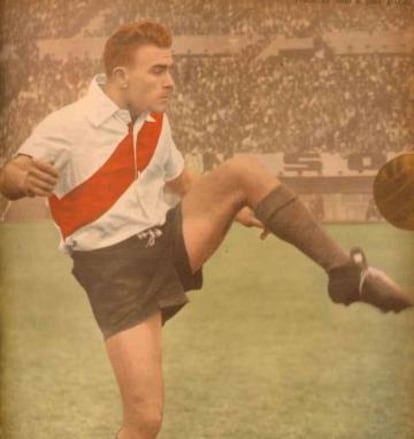How Real Madrid snatched Alfredo Di Stéfano from Barcelona FC
Documents discovered in Buenos Aires shed light on a transfer that changed soccer history

When Argentinean soccer legend Alfredo di Stéfano died in July 2014, Real Madrid, the team with which he won five European Cups and eight Spanish leagues between 1953 and 1964, went into mourning: this was a player who not only transformed the European game, but also reversed Real Madrid’s fortunes, helping set the club on the road to the enduring success it enjoys today.

But as documents discovered earlier this year show, he had first been transferred to Real Madrid’s arch-rival, Barcelona FC.
Files found at the offices of Di Stéfano’s former side, Buenos Aires-based River Plate, contained more than 30 documents detailing the contacts between River Plate, Barcelona, Real Madrid and Millonarios de Bogota, as part of a complex operation that is still shrouded in mystery.

The papers show how Barcelona bought the Argentinean forward, but that when he made his debut in Spain in September 1953, it would be in the all-white strip of Real Madrid.
The story dates to May 2 of that year, when Catalan businessman Domingo Valls Taberner was given “wide-ranging powers” to represent Barcelona FC in securing Di Stéfano, a player who had joined River Plate in 1947, and then moved to Millonarios, having also played for Argentina. Under FIFA rules at the time, he would have to return first to River Plate, by 1954.
River Plate initially asked $108,000 for Di Stéfano, and after some haggling Barcelona agreed to pay $87,000
River Plate initially asked $108,000 for Di Stéfano, and after some haggling Barcelona agreed to pay $87,000, the first half in cash by August 10, and the remainder in three installments by the end of 1954. The deal went ahead, as the documents bearing the signatures of senior officials at both sides show, although there was an important clause stating that Di Stéfano had to be in Barcelona by July 26, “having overcome any difficulties that could arise from his presence in Colombia.” Otherwise, the agreement would be rescinded.
Which is when Real Madrid appeared on the scene. The club decided to contact Millonarios directly, and then to approach River Plate. In a letter dated May 24, signed by the then-president of Real Madrid, Santiago Bernabéu, it introduced the club’s treasurer, Raimundo Saport Namías.

Four days later, River Plate received a telegram from Bogota saying that Millonarios had reached “a total agreement” with Real Madrid “to cede the transfer until October 1954 of Di Stéfano.” The Argentinean side replied that it had already reached agreement with Barcelona.
Seeming to cover its options, River also signed an agreement with Real Madrid saying that if Barcelona did not make its first payment by August 11, 1953, then River Plate would cede the player to Real Madrid.
On August 7, Barcelona paid the first installment. River Plate confirmed in writing that it was authorizing the transfer of Di Stéfano.
Real Madrid kept up the pressure on River Plate with another telegram, to which the Argentinean side replied that Barcelona had paid the first deposit and that the memorandum of understanding with Real Madrid was no longer valid.
Meanwhile, Di Stéfano, now aged 26, was in Barcelona waiting for the agreement to be settled, saying he refused to return to Millonarios.
The documents show that Barcelona’s claim on Di Stéfano looked shaky by September of 1953
Over the years there have been claims that General Francisco Franco intervened on behalf of Real Madrid. Either way, the documents discovered earlier this year in Buenos Aires show that Barcelona’s claim on Di Stéfano looked shaky by September of 1953. On September 7, the team contacted River Plate over press reports that the Argentinean side would not give Barcelona its deposit back. By now, Real Madrid had bought the remaining year of Di Stéfano’s contract from Millonarios, at which point, FIFA intervened, issuing the supposedly Solomonic decision on September 15 that the forward would play for Real Madrid that season, for Barcelona the next, and alternately for each side until 1957.
Barcelona refused to accept this and a month later sold Real Madrid the stake it had bought from River Plate.
On September 23, Di Stéfano made his debut for Real Madrid in a friendly against French team Nancy. At that point, Real Madrid had not won a title in two decades… the rest, as they say, is history.
English version by Nick Lyne.
Tu suscripción se está usando en otro dispositivo
¿Quieres añadir otro usuario a tu suscripción?
Si continúas leyendo en este dispositivo, no se podrá leer en el otro.
FlechaTu suscripción se está usando en otro dispositivo y solo puedes acceder a EL PAÍS desde un dispositivo a la vez.
Si quieres compartir tu cuenta, cambia tu suscripción a la modalidad Premium, así podrás añadir otro usuario. Cada uno accederá con su propia cuenta de email, lo que os permitirá personalizar vuestra experiencia en EL PAÍS.
¿Tienes una suscripción de empresa? Accede aquí para contratar más cuentas.
En el caso de no saber quién está usando tu cuenta, te recomendamos cambiar tu contraseña aquí.
Si decides continuar compartiendo tu cuenta, este mensaje se mostrará en tu dispositivo y en el de la otra persona que está usando tu cuenta de forma indefinida, afectando a tu experiencia de lectura. Puedes consultar aquí los términos y condiciones de la suscripción digital.
More information
Archived In
Últimas noticias
Most viewed
- Reinhard Genzel, Nobel laureate in physics: ‘One-minute videos will never give you the truth’
- Oona Chaplin: ‘I told James Cameron that I was living in a treehouse and starting a permaculture project with a friend’
- Pablo Escobar’s hippos: A serious environmental problem, 40 years on
- Why we lost the habit of sleeping in two segments and how that changed our sense of time
- Chevy Chase, the beloved comedian who was a monster off camera: ‘Not everyone hated him, just the people who’ve worked with him’










































